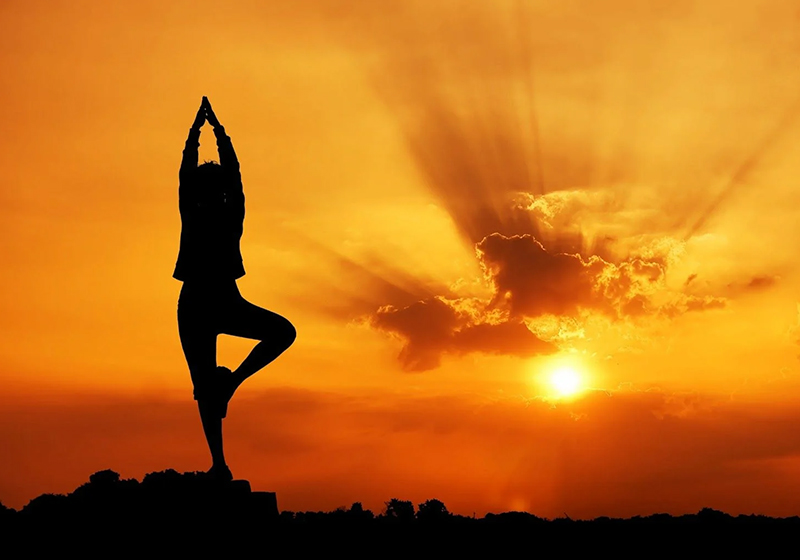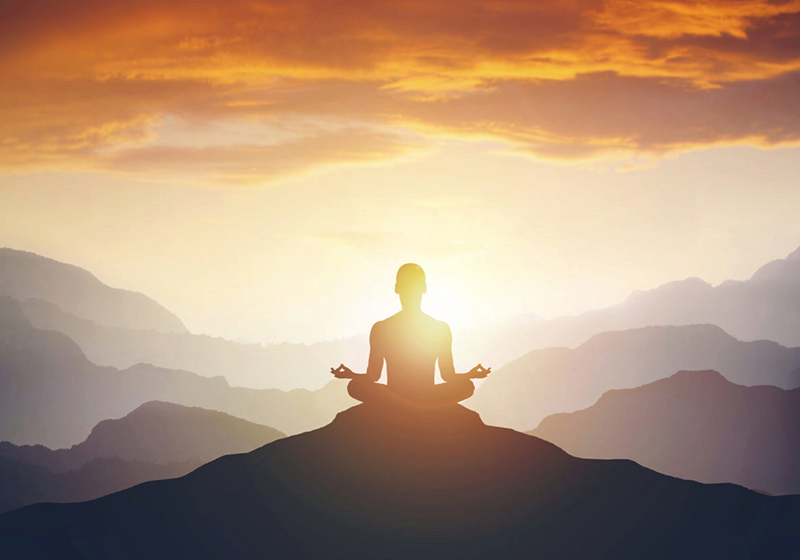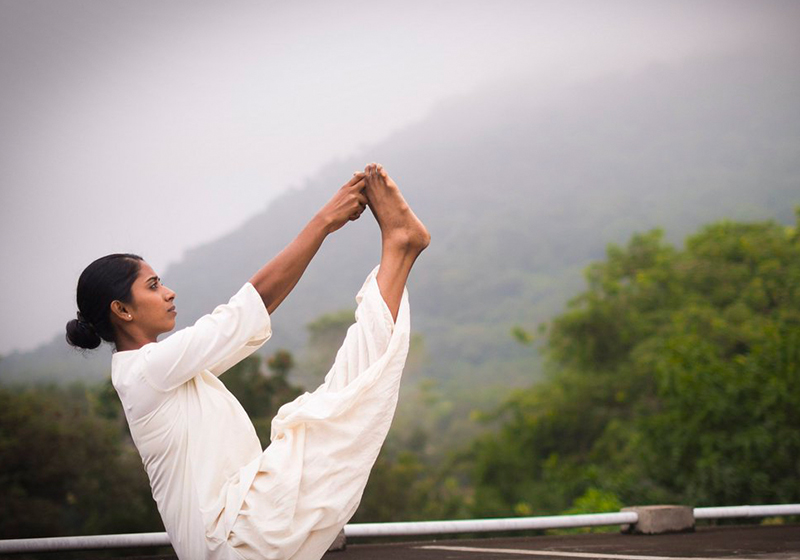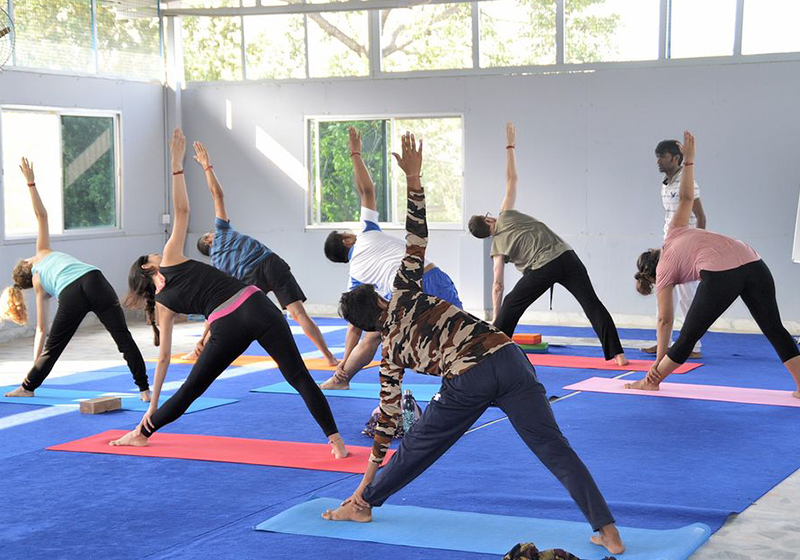Classes & Benefits
- Home
- Classes & Benefits

Surya Namaskar or Sun Salutation is a sequence of 12 powerful yoga poses. Besides being a great cardiovascular workout, Surya Namaskar is also known to have an immensely positive impact on the body and mind.
Practicing Surya Namaskar steps is best done early morning on an empty stomach. Each round of Sun Salutation consists of two sets, and each set is composed of 12 yoga poses. You might find several versions on how to practice Sun Salutation. However, it is advisable to stick to one particular version and practice it regularly for the best results.
Besides good health, Surya Namaskar also provides an opportunity to express gratitude to the sun for sustaining life on this planet.
Step 1. Pranamasana (Prayer pose)
Stand at the edge of your mat, keep your feet together and balance your weight equally on both feet. Expand your chest and relax your shoulders. As you breathe in, lift both arms up from the sides, and as you exhale, bring your palms together in front of the chest in a prayer position.
Step 2. Hastauttanasana (Raised arms pose)
Breathing in, lift the arms up and back, keeping the biceps close to the ears. In this pose, the effort is to stretch the whole body up from the heels to the tips of the fingers.
Tip to deepen this yoga stretch: You may push the pelvis forward a little bit. Ensure you're reaching up with the fingers rather than trying to bend backward.
Step 3. Hastapadasana (Standing forward bend)
Breathing out, bend forward from the waist keeping the spine erect. As you exhale completely, bring the hands down to the floor beside the feet.
Step 4. Ashwa Sanchalanasana (Equestrian pose)
Breathing in, push your right leg back, as far back as possible. Bring the right knee to the floor and look up.
Step 5. Dandasana (Stick pose)
As you breathe in, take the left leg back and bring the whole body in a straight line.
Step 6. Ashtanga Namaskara (Salute with eight parts or points)
Gently bring your knees down to the floor and exhale. Take the hips back slightly, slide forward, rest your chest and chin on the floor. Raise your posterior a little bit. The two hands, two feet, two knees, chest and chin (eight parts of the body) should touch the floor.
Step 7. Bhujangasana (Cobra pose)
Slide forward and raise the chest up into the Cobra pose. You may keep your elbows bent in this pose with the shoulders away from the ears. Look up at the ceiling.

There are a variety of meditation methods that suit most people, regardless of personality or lifestyle. However, there is no “right way” to meditate, meaning someone can explore the different types until they find one that works for them.
Meditation denotes an array of techniques that promote Trusted Source mind and body integration. Some types involve keeping mental focus on a sensation, while other types entail focusing awareness on the present without making judgments.
People use meditation to foster relaxation and heightened awareness in a stressful world where senses often become dull. Research suggests that meditation may have the potential to improve physical well-being, as well as emotional health, but most of the evidence is preliminary.
This article discusses the types of meditation, how long they take to work, and how often to meditate. It also looks at disadvantages and offers tips.

In the yoga tradition, the breath is said to carry a person's life force. Here's what you need to know to tap into yours.
In yoga, as in life, breathing can be taken for granted. It’s something we do automatically, involuntarily, unconsciously. But our yoga ancestors understood that breath is life. This is why pranayama or yogic breathing, is sometimes referred to as the “heart of yoga.”
Pranayama is the fourth of the Eight Limbs of yoga, but is just as important as asana, or the physical postures. From ancient times, yoga practitioners believed that pranayama had the power to bring the body and elevate the mind and spirit. In recent years, contemporary science supports what ancient tradition has taught for centuries: awareness of the breath can directly affect the quality of your health and your life.
What is pranayama?
While we often simplify the term pranayama to mean “breathwork,” the yogic meaning of pranayama is a bit more nuanced.
First, it’s helpful to understand the origins of the word. In Sanskrit as well as yoga tradition, prana means “life force,” and describes the energy that sustains the life of the body. Indu Arora, in her book Yoga: Ancient Heritage, Tomorrow’s Vision, breaks it down even further. “Pra means ‘primary, first, innate.’ Ana, from anu, means ‘the tiniest, smallest, indestructible unit of energy.”
The word pranayama is a combination of prana and ayama, which translates as “to extend, expand or draw out.” Some also say that the word is the combination of prana and yama, or “control.” With either translation, you arrive at the same concept: pranayama is a practice that involves the management or control of the breath. As implied by the literal translation of pranayama, yogis believe that this practice not only rejuvenates the body but actually extends life itself.
This fourth limb of yoga consists of techniques designed to gain mastery over the respiratory process while recognizing the connection between the breath, the mind, and the emotions.
Pranayama is an integral part of the yogic tradition, but not always an easy one to grasp, according to yoga teacher Tony Briggs. “Pranayama is meant to nurture a high level of bodily health and mental clarity, both of which are crucial steps on the path to self-knowledge and a wholesome, authentic life,” he writes.

Hatha yoga focuses on posture and breathing techniques, traditionally to channel vital energy source. In Sanskrit, Hatha translates to force. The practice involves breath, body, and mind, and classes are usually 45 minutes to 90 minutes of breathing, yoga poses, and meditation.
Hatha yoga breathing techniques can be traced back to the 1st Century in both Buddhist and Hindu texts, but it was another 1,000 years before the use of yoga postures, or asanas, and breath control was recorded as a way to enhance vital energy.
Health Benefits of Hatha Yoga
Yogis have long touted the calming and wellness benefits of practicing yoga. Today, research supports many of these claims.
The National Institutes of Health's National Center for Complementary and Integrative Health analyzed dozens of peer-reviewed studies and while most of the research was performed on small numbers of subjects, they found evidence to suggest yoga may be beneficial for the following conditions:
Anxiety and depression: Yoga can help relieve everyday anxiety and depressive symptoms, however, it may not be effective for clinically diagnosed mental health conditions. The NCCIH reviewed 68 published studies on yoga did not find conclusive evidence to support its effectiveness for managing anxiety disorder, depression, or PTSD.
Arthritis and fibromyalgia: According to the NCCIH, there is weak evidence to support yoga has benefits for osteoarthritis, rheumatoid arthritis, and fibromyalgia.
Back pain: The American College of Physicians recommends yoga as a non-drug method to treat back pain.2 A 2018 review of eight studies by the Agency for Healthcare Research and Quality found yoga improves low-back pain and function with both short-term and intermediate-term benefits, and its effects are similar to other types of exercise.
Back pain: The American College of Physicians recommends yoga as a non-drug method to treat back pain.2 A 2018 review of eight studies by the Agency for Healthcare Research and Quality found yoga improves low-back pain and function with both short-term and intermediate-term benefits, and its effects are similar to other types of exercise.
Balance: Yoga helps to improve balance in healthy people, according to 11 out of 15 studies reviewed by NIH.
Emotional health: Yoga has a positive impact on mental health and was shown to have benefits of improving resilience or general mental well-being in 10 out of 14 studies reviewed by NCCIH.
Menopause: Yoga can relieve physical and psychological symptoms of menopause, including hot flashes, according to the NCCIH review of more than 1,300 study participants.

Ayurveda is an alternative medicine system with historical roots in the Indian subcontinent. The theory and practice of Ayurveda is pseudoscientific. Ayurveda is heavily practiced in India and Nepal, where around 80% of the population report using it.
Ayurveda therapies have varied and evolved over more than two millennia.Therapies include herbal medicines, special diets, meditation, yoga, massage, laxatives, enemas, and medical oils.Ayurvedic preparations are typically based on complex herbal compounds, minerals, and metal substances (perhaps under the influence of early Indian alchemy or rasashastra). Ancient Ayurveda texts also taught surgical techniques, including rhinoplasty, kidney stone extractions, sutures, and the extraction of foreign objects.

Ashtanga has been considered one of the most popular forms of yoga in the Western world. Ashtanga centers on a vigorous physical practice that includes a series of poses linked together with breath to form a continuous sequence. The practice demands an intense level of physical strength, flexibility, and endurance, which explains why many people see it as a rigorous and challenging workout. Whether you’re just starting out in yoga, or looking for something new as your goals change, adding an Ashtanga yoga class to your daily workout is a good way to keep your mind and body healthy and strong.
What Is Ashtanga Yoga?
The word Ashtanga is comprised of two Sanskrit words, “Ashta” and “Anga.” “Ashta” refers to the number eight, while “Anga” means limb or body part. Therefore, Ashtanga is the union of the eight limbs of yoga, into one complete, holistic system. These eight-limbs of yoga represent the various branches of the philosophy of the yoga sutras that form the foundation in the Ashtanga Yoga School. The Ashtanga philosophy is to integrate all of the eight limbs of yoga, which include: Yama (moral codes), Niyama (self-discipline), Asana (posture), Pranayama (breath control), Pratyahara (sense withdrawal), Dharana (concentration), Dhyana (meditation), and Samadhi (oneness with the self).
Ashtanga is a very dynamic and athletic form of hatha yoga, made up of six series or levels, with a fixed order of postures. It is rooted in vinyasa, the flowing movements between postures, with a focus on energy and breath. While it is a very physical practice, it also promotes mental clarity and inner peace.
Ashtanga posture sequences
Usually, students begin an Ashtanga practice with five repetitions of Sun Salutation A and Sun Salutation B. This is followed by a set of standing poses, in 5 repetitions, then a set of seated poses. After you have mastered these three pose sequences, your instructor will guide you through the advanced series, Advanced A, and Advanced B, Advanced C, and D.